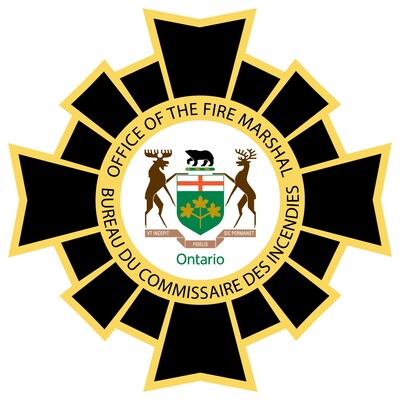Office of the Fire Marshal Warns Ontarians of Growing Lithium-Ion Battery Fire Risks During Fire Prevention Week
As lithium-ion battery-powered devices surge in popularity, so do the fire risks
TORONTO, Oct. 5, 2025 /CNW/ - The Office of the Fire Marshal (OFM) is warning Ontarians about the risks of lithium-ion battery fires as Fire Prevention Week, October 5 to 11, 2025, is now underway. This year's theme, "Charge into Fire Safety™: Lithium-Ion Batteries in Your Home," highlights the critical importance of safe charging, proper use, and following manufacturer's instructions to help prevent these dangerous fires.
"Lithium-ion batteries are not like regular batteries," said Ontario Fire Marshal Jon Pegg. "When they fail, they can unleash a chain reaction that results in an intense fire that can spread in seconds, release toxic smoke, and make escape incredibly difficult."
The number of lithium-ion battery-related fires is rising sharply across the province with the increasing number of household devices, such as phones, laptops, power tools, e-bikes and scooters, powered by them.
These fires often begin with overheating. If the battery is damaged, tampered with, or charged improperly, this overheating can spiral into thermal runaway — a self-sustaining reaction in which heat is generated faster than it can dissipate, resulting in fire and, in some cases, explosion. These fires burn hotter and faster than other types of fires and produce thick, toxic smoke.
"Lithium-ion battery fires present a new, significant challenge to the fire service," continued Fire Marshal Pegg. "But like many other types of fires, they can be prevented by following simple safety tips."
When used as intended, lithium-ion batteries will perform well. The public is urged to follow these tips to stay safe:
- Always follow manufacturer's instructions for the use, charging, storage and disposal of lithium-ion batteries.
- Always use the charger and battery that came with the device — never substitute batteries with uncertified or off-brand alternatives. Devices and their batteries are engineered to work together. Substituting uncertified chargers or third-party batteries undermines these safety designs and dramatically increases the risk of failure.
- Unplug devices once they are fully charged and avoid charging overnight or while unattended.
- Never modify or tamper with lithium-ion batteries — and never attempt to build your own.
- Protect batteries from physical damage (punctures, crushing, or water exposure).
- Do not leave devices in the rain or snow.
- Recycle batteries at approved drop-off locations. Never put them in household garbage or blue bins.
For more information, visit www.chargedforlife.ca and follow the OFM @ONFireMarshal.
SOURCE Office of the Fire Marshal


